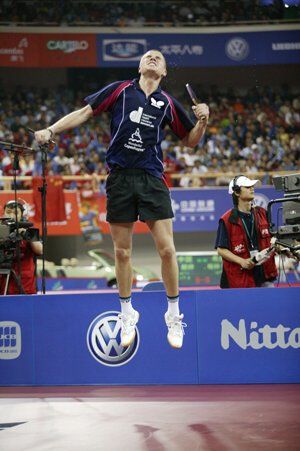
Photo by: Rémy Gros, courtesy www.ittf.com
It is time to talk about how to identify your own strengths and weaknesses in table tennis, so that you can use this knowledge to help you select the correct tactics when playing a particular opponent.
What is a Strength?
While this can seem like an obvious question with an simple answer, there are actually a few different ways to define your strengths. I wouldn’t go far as to say that any of the definitions below are the definitive solution, but they are all worth thinking about.
A Strength Is:
- Something that wins you points – whether it is a stroke, superior tactics or fitness, or attitude.
- Something that you do that is better than the rest of your game – such as a powerful forehand loop or tight return of serve.
- Something that you do better than your current opponent – such as having a better backhand loop than he does.
The first two definitions are fairly traditional and well accepted, while the last leads to some interesting conclusions. If you agree with it, it follows that your strengths may actually not always be the same, but may change depending on your opponent! Something worth mulling over, wouldn’t you say?
More Than Meets the Eye…
Another thing to remember is that there is much more to strengths than just stroke-making. Tactics, mental toughness, fitness, footwork, reflexes, read of spin, anticipation, strength, timing etc can all be something that is a strength in your game.
How Do You Identify Your Strengths?
Now that we have a reasonable idea of what a strength in table tennis is, we can go on talk about how to work out what strengths you actually have. Some methods that are used to identify strengths are listed below.
- Work out which shots win you points. This can be true, but you need to be careful when applying this rule – you may think that your point-winning smash is a strength, when actually the spinny loop that you use to set up the smash is where your real strength lies. This leads to the next method.
- Work out which shots set up your winning shots. As mentioned above – your point finishing strokes may only be average, but you may excel at preparing for these shots with your setup stroke.
- Work out what shots you enjoy playing. This can sometimes be correct, since we mostly enjoy doing what we can do well, but sometimes people do enjoy trying to play shots that they shouldn’t – I think we all know someone in table tennis that likes to go for the flashy, low percentage shot – they probably enjoy it when the ball goes on, but you wouldn’t call it a strength – it’s more like a weakness really.
- A shot that feels easy to do. Maybe, but does it fit in with the rest of your game? You may find backhand chopping easy, but if you are a two wing looper, it’s not going to be a strength.
- What loses you few points. This would most probably be a strength, provided it is part of your regular game. If you are a chopper and lose few points from your forehand chop, that is probably a strength. You would also probably lose few points from your backhand loop as well, but since you hardly ever use it that wouldn’t qualify as a strong part of your game.
- What other people think are your strengths. It can be a good idea to have someone else critique your game, and look for your strengths. The quality of the advice you get will depend on the quality of the advisor though, so look for an experienced and knowledgeable coach or player if you can find one.
- What the camera says are your strengths. If you can, get video footage of yourself playing as often as possible against different opponents. Watch the footage and make notes of what strokes and strategies are winning you points.
What Is a Weakness?
In general, I would argue that a weakness in table tennis should be the opposite of your strengths. This would lead to the following conclusions.
A Weakness Is:
- Something that loses you points – whether it is a stroke, tactics, fitness, or attitude.
- Something that you do that is worse than the rest of your game – such as a erratic forehand loop or loose return of serve.
- Something that you do worse than your current opponent – such as having worse footwork than he does.
How Do You Identify Your Weaknesses?
Continuing in the same vein, you should be able to identify your weakness using some or all of the following methods, if used appropriately.
- Work out which shots lose you points.
- Work out which strokes set up your opponent’s winning shots.
- Work out what shots you don’t enjoy playing.
- A shot that feels hard to do.
- What wins you few points.
- What other people think are your weaknesses.
- What the camera says are your weaknesses.
Conclusion
Using the above information, you should be well on your way to identifying the best and worst points of your table tennis game. Once you know yourself well, the next step is to apply the same reasoning to your opponent, so that you can work out his strong areas and vulnerabilities. Armed with this knowledge, you are then ready to proceed to working out your actual match tactics for that opponent.

